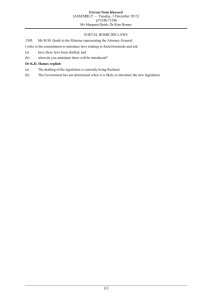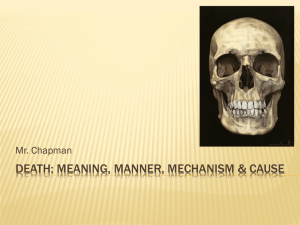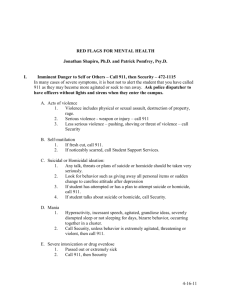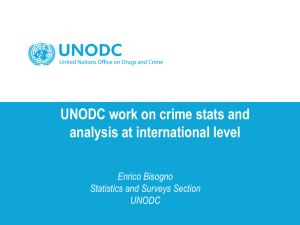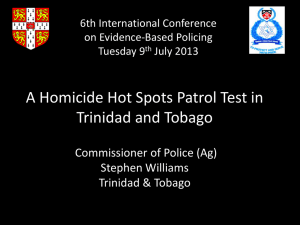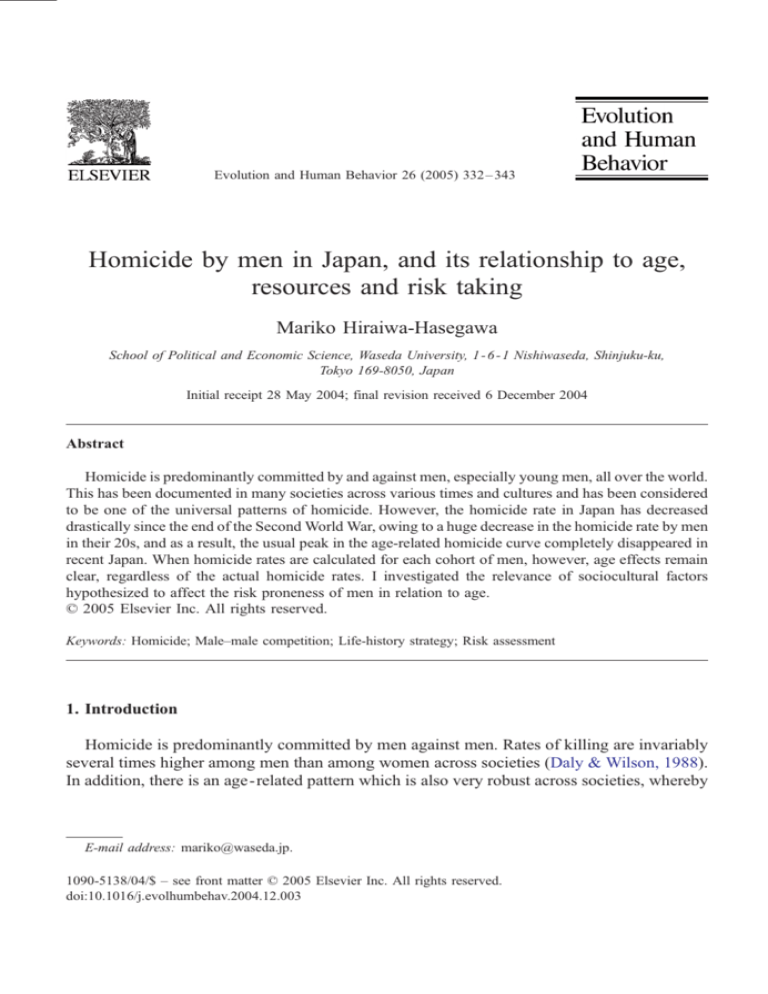
Evolution and Human Behavior 26 (2005) 332 – 343
Homicide by men in Japan, and its relationship to age,
resources and risk taking
Mariko Hiraiwa-Hasegawa
School of Political and Economic Science, Waseda University, 1 - 6 - 1 Nishiwaseda, Shinjuku-ku,
Tokyo 169-8050, Japan
Initial receipt 28 May 2004; final revision received 6 December 2004
Abstract
Homicide is predominantly committed by and against men, especially young men, all over the world.
This has been documented in many societies across various times and cultures and has been considered
to be one of the universal patterns of homicide. However, the homicide rate in Japan has decreased
drastically since the end of the Second World War, owing to a huge decrease in the homicide rate by men
in their 20s, and as a result, the usual peak in the age-related homicide curve completely disappeared in
recent Japan. When homicide rates are calculated for each cohort of men, however, age effects remain
clear, regardless of the actual homicide rates. I investigated the relevance of sociocultural factors
hypothesized to affect the risk proneness of men in relation to age.
D 2005 Elsevier Inc. All rights reserved.
Keywords: Homicide; Male–male competition; Life-history strategy; Risk assessment
1. Introduction
Homicide is predominantly committed by men against men. Rates of killing are invariably
several times higher among men than among women across societies (Daly & Wilson, 1988).
In addition, there is an age-related pattern which is also very robust across societies, whereby
E-mail address: mariko@waseda.jp.
1090-5138/04/$ – see front matter D 2005 Elsevier Inc. All rights reserved.
doi:10.1016/j.evolhumbehav.2004.12.003
M. Hiraiwa -Hasegawa / Evolution and Human Behavior 26 (2005) 332–343
333
rates of homicide by men rise sharply after puberty to a peak in the early 20s and then decline
less steeply (e.g., Daly & Wilson, 1988; Hirschi & Gottfredson, 1983).
Common motives when men kill men are seemingly trivial conflicts over social status,
face, pride, and reputation, as well as conflicts over material resources. An evolutionary
explanation for these patterns is that natural selection has shaped young men to be more risk
prone and to discount the future more than other people do: Prior to their own reproduction,
young men are relatively likely to adopt risky behavioral options in social confrontations
because they have higher potential reproductive gains and/or less to lose than older men
(Daly & Wilson, 1997; Rogers, 1994). If this is the case, the age pattern in homicide will be
maintained irrespective of the overall homicide rate, and this expectation is supported by the
almost identical age curves for homicide in the United States, Canada, and Britain, despite
huge differences in these nations’ total homicide rates (Wilson & Daly, 1993).
Japan presents an anomaly to this widespread pattern. The homicide rate in Japan has
decreased steadily since 1955, due to a dramatic decrease in homicides by young men. There
is no peak in the age-related homicide rate curve in contemporary Japan, and the so-called
buniversal age-related patternQ has completely disappeared. I believe that this is the first
reported case where age differences in homicide rates have become so inconspicuous.
In this paper, I first describe this chronological change and then investigate several
socioeconomic factors to explain this Japanese anomaly. The Japanese pattern suggests that
sometimes the age effect on homicide rate can be superseded or masked when dynamic social
change occurs and when the change does not have the same effects on different age groups.
Finally, I propose a model to incorporate factors related to men’s decision making regarding
whether to adopt risky behavioral options in the face of social confrontation.
The social and economic situation in Japan has changed enormously since the end of the
Second World War. Several studies in other countries have addressed the ways in which
social factors can affect age-related homicide rates (Greenberg, 1985; O’Brien, Stockard, &
Isaacson, 1999; Savolainen, 2000), but in each case, the usual pattern of higher homicide
rates among young men than among older men persisted. Japan presents an exception and is
thus an excellent vehicle to examine the social and economic mediation of age effects.
2. Methods
I used the National Annual Crime Statistics issued by the Police Department, and the Vital
Statistics issued by the Ministry of Health, to calculate overall homicide rates and age-related
homicide rates. Data from the National Annual Crime Statistics include the (1) numbers of
homicide cases reported, (2) numbers of homicide arrests, (3) numbers of perpetrators in each
age category (14–15, 16–17, 18–19, 20–24, 25–29, 30–39, 40–49, 50–59, 60–69, 70–79,
and over 80 years old) and sex, and (4) several socioeconomic status variables for the
perpetrators, although these are not fully consistent over years (e.g., they include income in
some years, but not in others).
The Japanese homicide statistics analyzed here differ from those used in most studies of
homicide elsewhere in three ways. First, the Japanese cases include attempted murders, in
334
M. Hiraiwa -Hasegawa / Evolution and Human Behavior 26 (2005) 332–343
50
45
40
homicide/million
35
30
25
20
15
10
1996
1990
1984
1978
1972
1966
1960
1954
1948
1942
1936
1930
1924
1918
1912
1906
0
1900
5
Fig. 1. Changes in the annual homicide rate per million people in Japan during the 20th century.
which a perpetrator made a physical assault on a victim with intent to kill, but did not succeed
in doing so. Such attempted murders constitute about half of all the archived homicides, a
proportion that remained fairly constant throughout the surveyed years. Second, cases in
which killers were deemed lacking in intent to kill, but resulted in killing, are not included in
the Japanese archives analyzed here. They are called blethal assault.Q Third, robberies
associated with murder are also not included, when the robbery was the main purpose of the
crime. They are called brobbery murder.Q Those two categories, that is, blethal assaultQ and
brobbery murder,Q are not included in the Japanese archives. Every year, those two categories
of killings amount to about 10% to 15% of all homicide.
For a more detailed analysis of the motives and socioeconomic characteristics of
perpetrators, I collected 1768 decisions made by the district courts of Sapporo, Aomori,
Iwate, Niigata, Kanazawa, Kohu, Urawa, Tokyo, Yokohama, Chiba, Numazu, Osaka, Kobe,
Kochi, and Fukuoka on homicide cases from 1989 to 1999. Access to decisions made prior to
1989 was very difficult, but I could access 780 judicial decisions on homicide from the early
1950s, which were compiled and summarized in a report issued by the Legal Training and
Research Institute (Irie, 1959). These cases apparently represent a random sample of
homicides from all over Japan, which occurred between 1950 and 1954 and for which the
first decision was made at the district court by the end of 1955.
There were few cases of recidivism in these data: fewer than 5 of the more recent 1768
cases. Whether this is also true for the older data is unknown because of the lack of identity of
the perpetrator in these records.
Data on the gross domestic product of Japan were derived from the economic statistics
issued by the Ministry of Economy, Trade, and Industry. Data on unemployment rates,
household income, and Gini indices of income inequality (calculated on the basis of total
household income after tax redistribution) were derived from the labor and income statistics
issued by the Ministry of Health, Labor, and Welfare. Data on college enrollment were
derived from statistics issued by the Ministry of Education.
M. Hiraiwa -Hasegawa / Evolution and Human Behavior 26 (2005) 332–343
335
3. Results
3.1. Descriptive statistics
3.1.1. Overall chronological changes in homicide rates in Japan
The homicide rate in Japan was between 35 and 50 per million people per annum during most
of the first half of the 20th century, except for the brief period during the Second World War.
However, it has constantly decreased since 1955 and now is only about 10 per million (Fig. 1).
Because half of these are attempted murders, this makes the actual murder rate in recent Japan
only about 5 per million, probably one of the lowest in the world (World Health Organization,
2003). Fig. 2 depicts homicide rates per million adults (over 20 years old) per annum from 1955
to 2000. Both men’s and women’s homicide rates decreased, but the decrease in cases
committed by men is far more conspicuous and is furthermore proportionately larger: Men’s
homicide rate in 2000 was one fifth of that in 1955, whereas women’s rate in 2000 was two
fifths of that in 1955.
3.1.2. Age-related homicide rates by men
Fig. 3 portrays changes in homicide by Japanese men over time, by showing age-related
rates for each 5-year interval since 1955. The 1955 data exhibit the familiar pattern of a steep
rise in the late teens and early 20s followed by a decline. However, homicides by young men fell
steadily and dramatically after 1955, and the peak in young adulthood disappeared by 1990. By
1975, the rate in the 25–29 age category surpassed that of men 20–24. In 1980, the highest rates
were by men in their 30s, and in 1990 by men in their 40s. In 2000, the homicide rate for men in
their 50s was actually higher than that for men aged 20–24. In 1955, the rate for men in their 20s
was 2.12 times that of men in their 30s; by 2000, this ratio had fallen to 0.78. Thus, the decline
in homicides by young men is the major cause of the overall decline in Japanese homicide.
3.1.3. The motives of homicide by men
Although each homicide has its own background and course of events specific to the case,
we can divide the cases into a few categories based on the nature of the conflict. Aside from
Fig. 2. Changes in the annual homicide rate per million adult males and females over 20 years old from 1955 to
2000 in Japan.
336
M. Hiraiwa -Hasegawa / Evolution and Human Behavior 26 (2005) 332–343
homicide/million
a
250
200
1955
150
1960
100
1965
1970
50
1975
0
0 5 10 15 20 25 30 35 40 45 50 55 60 65 70
age
homicide/million
b
60
50
40
30
20
10
0
1980
1985
1990
1995
2000
0
5 10 15 20 25 30 35 40 45 50 55 60 65 70
age
Fig. 3. Changes in age-related homicide rates per million male population in Japan: (a) 1955 to 1975; (b) 1980
to 2000.
the few cases where the perpetrator carefully planned the killing (e.g., to get life insurance
money, or in revenge killings by Yakuza, the Japanese bmafiaQ), most of the homicides
occurred rather spontaneously in the context of some superficially trivial dispute. Even when
there has been trouble between the two parties for a while, the immediate cause of killing is
usually one incidence of heated dispute over the sustained conflict, and what is at stake in
such disputes is often face, pride, or social status (Daly & Wilson, 1988). Other conflicts
include those over business and money, as well as those involving sexual jealousy. All of
these can be regarded as conflicts in which men are fighting to impose control over others.
Of the 780 cases from the early 1950s, 273 involved men killing other men. As for the
recent cases, I extracted 699 such cases from the 1990s data. Proportions in each motive
category in these two periods are portrayed in Table 1. Despite the large difference in rates of
homicide between these periods, men’s motives for killing changed little: altercations over
Table 1
Proportion of each motive category in homicides committed by men in Japan in the 1950s and 1990s
Motives
1950s (N = 273)
1990s (N = 699)
Face, status (%)
Business conflict
Dispute over money
Jealousy conflict
Self-defense
Others
69.6
10.3
8.4
10.6
0.0
1.1
61.2
4.3
10.7
9.9
3.6
10.3
M. Hiraiwa -Hasegawa / Evolution and Human Behavior 26 (2005) 332–343
337
social status, face, and pride constituted more than 60% of the cases both in the 1950s and
in the 1990s.
3.2. A risk-assessment model of homicide
The prevailing explanation for the typical pattern whereby homicide rates peak in the late
teens and early 20s is that young men just prior to the onset of their own reproduction have
more to gain and less to lose by taking risky behavioral options in social conflict than do
older men. If they win a confrontation, they can gain higher social status or a tough
reputation, which may be very important to their future reproduction.
If age were the essential factor, the pattern of age-related homicide rates would not change
even when the overall homicide rate of a society changed, but this was not the case in Japan.
However, it could still be the case that age is a major determinant of men’s risk proneness, but
that age effects in homicide disappeared because certain social changes had different effects
on different age cohorts (bgenerationsQ) and the data were presented cross-sectionally.
By winning social confrontations, men can gain status or reputational benefits that increase
their ability to control other people and enhance their resource-holding ability, and this, in
turn, increases their expected reproductive success. Hence, suppose that a man has two
behavioral options in social confrontations: a risky option that could lead to homicide and an
alternative that entails no such risk. If the man takes the risky option and wins, he will gain a
lot, in resource-holding ability and expected reproductive success, and he will be able to
retain his current resources, if he has any, but if he loses, he cannot improve his resourceholding ability and he jeopardizes his current resource holdings, if any. If he instead chooses
the non-risky option, he can, at best, end the confrontation and maintain his status quo, but he
will not increase his resource-holding ability, and he may have to incur reputational or other
costs to resolve the confrontation without risk.
I propose that, if a man has few or no resources, it is beneficial for him to take the risky
option in a social confrontation, because, if he wins, he can build up higher resource-holding
ability, which will lead to higher future reproductive success, and he has little to lose if he
loses. Taking the non-risky option cannot improve his resource-holding ability and may
actually damage it by giving him a reputation of weakness, or may otherwise impose a cost he
cannot afford. However, for a man with a lot of resources, the risky option is less appealing
because his resource-holding ability is already high, he will jeopardize his current resources
if he loses, and he can afford to pay the cost of adopting the non-risky option that will
maintain his status quo.
I argue that this scenario works for every man, regardless of his age. However, because
both the costs and benefits of the risky behavior are usually higher for young men than for
older men, due to their higher reproductive value, the effect of current resources on the
probability of taking a risky option is larger among young men than among older men. Young
men with no current resources will be much likelier to resort to risky options than do older
men with no current resources, but when a young man has resources, he will be ready to
switch to a risk-avoiding option because the cost to his future reproductive success, when he
loses, is higher than that for older men. This model suggests that young men are more
338
M. Hiraiwa -Hasegawa / Evolution and Human Behavior 26 (2005) 332–343
Table 2
Distribution of each economic class among male homicide offenders and among the general Japanese population,
averaged from 1955 to 1963
Economic class
Homicides (%)
General population (%)
Very poor
Poor
Moderate
Affluent
Very affluent
6.97
61.3
30.8
0.88
0.03
6.25
25.9
40.1
20.6
7.15
sensitive to the valuable resources that they have for their future and change their behavior
accordingly. Therefore, if certain social changes had the effect of improving young men’s
resource status relative to older men, we might observe a cross-sectional pattern in which
homicide rates for older men surpassed those for younger men, and we could explain the
unusual patterns of age-related homicide rates in recent Japan.
3.3. The potential sociocultural factors affecting men’s resource
The above model suggests that a man’s current resource status has a significant effect on
his probability of taking risky behavioral options in social confrontations. The most obvious
example of the man’s resource status is his income. The National Annual Crime Statistics
include categorical data on homicide perpetrators’ incomes from 1959 to 1963: bvery poor,Q
bpoor,Q bmoderate,Q baffluent,Q and bvery affluent.Q Quantitative definitions for these
categories are not stated, thus, it is difficult to compare perpetrators with the population in
general, but I divided the general population into five similar categories using household
income statistics and compared it with the data on homicides (Table 2). The result suggests
that homicides were significantly poorer than the population in general.
Another candidate index of resource status is employment status. Having a permanent job
is one indicator of a man’s resource-holding ability, and it would also give him a secure
prospect of his future. The National Annual Crime Statistics include the employment status of
criminals in all years. I calculated the proportion of unemployed among homicide perpetrators
and among an age-matched subpopulation sampled from the general Japanese, for the 1970s
and 1980s. The proportion of homicide perpetrators who were unemployed was 26.8% in the
1970s and 32.9% in the 1980s, compared with 12.3% and 8.8%, respectively, for the agematched general population sample. This shows that homicides were significantly more often
unemployed than are the general population in both periods, and that employment status
became a stronger risk factor in the 1980s.
Lastly, I looked at the completed school records of homicides and the population in
general. The completed school record represents the level of investment in education, which
is clearly an investment for the future. More schooling means better job opportunities in the
future and is thus a valuable asset. I compared the distribution of completed school records
among homicides with that among the general population during 1990s (Table 3). People
with relatively little education were overrepresented among homicide perpetrators.
M. Hiraiwa -Hasegawa / Evolution and Human Behavior 26 (2005) 332–343
339
Table 3
Distribution of the highest completed level of schooling among male homicide offenders and the male population
at large in Japan during the 1990s
The last completed school record
Homicides (%)
All male population (%)
No school
In school
Obligatory school
High school
Colleges
1.1
0.0
60.1
27.8
10.9
0.02
1.4
25.1
45.1
27.2
200
0.35
180
140
0.25
120
100
0.2
80
0.15
60
40
0.1
0.05
20
0
H
C
96
93
19
90
19
87
19
84
19
81
19
78
19
75
19
72
19
69
19
66
19
19
63
0
19
19
GINI indeces
0.3
160
60
Homicide rate/College enrollment
These results clearly demonstrate that a man’s current resource status was an important
predictor of whether he would resort to risky behavioral options. The question, then, is
whether social and economic changes in Japan after the Second World War had positive
effects primarily or solely on the resource status of young men rather than of older men.
One of the most conspicuous changes in Japan after the War is its miraculous economic
growth. The GDP of the nation steadily increased, while income inequality (as measured by
the Gini index) declined (Fig. 4). This means that people in Japan not only became richer, but
that wealth was more evenly distributed. Thus, a substantial proportion of the contemporary
Japanese population is well endowed with resources. Meanwhile, the number of children per
household decreased from about 5.2 before the War to 1.8 in 1990s; hence, as family size
decreased while the parents themselves became richer, competition among children must have
diminished such that each child would be endowed with relatively ample resources.
Moreover, the proportion of young men who proceeded to universities and colleges
increased from about 13% in 1955 to more than 40% in the 1990s (Fig. 4), meaning that as
economic development in postwar Japan proceeded, the proportion of young men with a high
investment in education for future prosperity increased. Those men are seeking better job
G
Fig. 4. Changes in annual homicide rates per million males 20 to 24 years old, with concomitant changes in the
Gini index of income inequality and college enrollment rates, from 1960 to 1996.
340
M. Hiraiwa -Hasegawa / Evolution and Human Behavior 26 (2005) 332–343
opportunities with their completed school records as an asset and are therefore expected to be
highly risk avoiding in social confrontations.
To investigate the relationships among young men’s homicide rates, Gini indices, and
college enrollment, I ran a multivariate analysis using Gini index and college enrollment
rate as independent variables and the homicide rate for 20- to 24-year-old men as the
dependent variable. I used 37 data points from 1960 to 1996 because the method for
calculating the Gini index was consistent only during those years. The result showed a
significant negative effect of college enrollment rate and a significant positive effect of the
Gini index on the young male’s homicide rate (t = 5.39, df =36, p b.001 for college
enrollment; t =3.92, df =36, p b.001 for the Gini index). However, the analysis of residuals
suggested that there was a structural change in college enrollment rate after around 1985.
Indeed, the increase in college enrollment among young men more or less stopped around
1985. Therefore, I tested the regression with a new model which incorporated this structural
change after 1985, and the result produced a better fit (t = 5.07, df =36, p b.001 for college
enrollment rate; t =5.94, df =36, p b.001 for the Gini index; F =31.79, df =3, p b.001: F test
for the structural change).
3.4. Age and homicide rate: cohort analysis
Fig. 3 depicts cross-sectional data on homicide rate by age. Although Fig. 3b exhibits an
unusual pattern whereby homicide rates by middle-aged men are the highest, these are not the
same cohort of men. During periods of dynamic social change like that following the Second
World War in Japan, such a cross-sectional depiction may be misleading. I therefore
calculated homicide rates by cohort, as shown in Fig. 5, where it is evident that for each of
nine cohorts, homicide rates were always highest in the 20s and decreased with age,
regardless of the rate differences among cohorts. This implies that when more young men are
endowed with resources, they become more and more risk avoiding, but the age effect persists
even if it becomes very small.
Homicide rate/million
200
1886-1895
150
1896-1905
1906-1915
100
1916-1925
50
1926-1935
1936-1945
er
1946-1955
1956-1965
60
an
d
ov
50
s
40
s
30
s
20
s
0
1966-1975
Fig. 5. Age-related homicide rates for nine different cohorts of men in Japan.
M. Hiraiwa -Hasegawa / Evolution and Human Behavior 26 (2005) 332–343
341
4. Discussion
In Japan, the homicide rate has decreased drastically since the Second World War. This
should not be surprising, given that Japan experienced huge economic growth with a
simultaneous decrease in inequality. It has already been demonstrated that lower levels of
inequality are associated with lower homicide rates (e.g., Daly, Wilson, & Vasdev, 2001;
Wilson & Daly, 1997).
The decrease in the Japanese homicide rate consisted mainly in a huge decrease in killings
by young men. The usual age pattern, which has even been called binvariantQ (Hirschi &
Gottfredson, 1983), completely disappeared by 1990. Other studies have both shown that the
pattern was by no means invariant and investigated the sources of variability (e.g., Greenberg,
1985; O’Brien et al., 1999), but to the best of my knowledge, there has been no prior report of
such a large and rapid decrease in homicides by young men as we have seen in Japan.
Several previous studies have shown that men who kill tend to have few economic and
social resources to protect (Daly & Wilson, 1988, 1990; Wilson & Daly, 1985). This research
confirmed the previous results. How is this related to the beffectsQ of age? From an
evolutionary point of view, age is certainly an important factor affecting men’s willingness to
take risks, because age is directly connected to reproductive value, and the analysis of age
patterns within cohorts (Fig. 5) confirmed the importance of age: Within each cohort, the
homicide rate always decreased monotonically with age, although this effect was small. The
change that occurred in Japan suggests that when social situations change drastically with
different effects on different generations, we can have a grossly distorted age–crime curve
when looked at cross-sectionally.
I presented a hypothesis to explain the relationships between a man’s tendency to resort to
risky options in social conflict, his current resources, the effect of winning on his resourceholding ability, and the effect of resource-holding ability on his future reproductive success.
Many of the social and economic changes which took place in Japan after the Second World
War helped young men acquire more resources. Their parents got richer and the number of
children per household got smaller, thus, men of the younger generation were raised in better
resource circumstances than were the older generations. Presumably, this made them feel
more satisfied in their current condition than did the older generations when they were young.
A related consideration is the resource value of higher investment in education.
Considerable amounts of time and money are invested in young men’s higher education,
and better school records certainly bring better job opportunities. Moreover, secure
employment for life and an age-dependent salary system have been the norm in major
Japanese companies throughout the period of high economic growth. These Japanese customs
assured that if a young man has a good university certificate and is employed by a company,
his job was secure and his salary increased steadily until retirement at about 60 years old,
barring misbehavior. This system would provide a young man with unusually secure life
prospects if he can maintain a good reputation. This system definitely expanded young men’s
btime horizonsQ (Wilson & Herrnstein, 1985).
When a young man has few resources, the potential gains from risky option loom large
relative to the costs. Therefore, when young men’s resources are considerably smaller than that
342
M. Hiraiwa -Hasegawa / Evolution and Human Behavior 26 (2005) 332–343
of older men’s, as is probably the norm in many human societies, homicide rates of men should
be highest among late adolescents and early adults. Japanese society used to be like that.
Although risky options always entail a risk of lost resources, this would have more serious
effects on young men than on older men because of the former’s higher reproductive value.
Thus, young men should quickly become risk avoiding as their resource status improves. The
rapid social and economic changes during the economic growth after the war in Japan have
changed young men’s resources and future prospects drastically, and indeed, the decrease in
homicide rate was most conspicuous among men 18 to 25 years old.
Just what counts as resources and what kind of resource-holding ability affects future
reproductive success depend on culture. In the case of Japanese society, high investment in
education was one such resource. However, it may not be the same in other cultures.
Acknowledgments
I would like to express my sincere gratitude to Martin Daly and Margo Wilson, who
invited me to step into the field of evolutionary psychology. My deep thanks also go to
Toshikazu Hasegawa for his discussion and support on this work, and to my former assistant,
Kohei Tsuji, who helped me with analyzing all the data. Staffs at the district courts of
Sapporo, Aomori, Iwate, Niigata, Kanazawa, Kohu, Urawa, Tokyo, Yokohama, Chiba,
Numazu, Osaka, Kobe, Kochi, and Fukuoka kindly took their time to sort out homicide cases
and made massive copies of them. Martin Daly, Margo Wilson, and two anonymous referees
gave me many valuable suggestions to improve the analysis. The research was partially
supported by the Ministry of Education, Science, and Culture (basic research fund to
Professor Yoshiko Iwai, Senshu University), and by an award to the author from the special
research fund for new faculty of Waseda University.
References
Daly, M., & Wilson, M. (1988). Homicide. Hawthorne, NY7 Aldine de Gruyter.
Daly, M., & Wilson, M. (1990). Killing the competition. Human Nature, 1, 83 – 109.
Daly, M., & Wilson, M. (1997). Crime and conflict: Homicide in evolutionary psychological perspective. Crime
and Justice, 22, 51 – 100.
Daly, M., Wilson, M., & Vasdev, S. (2001). Income inequality and homicide rates in Canada and the United States.
Canadian Journal of Criminology, 43, 219 – 236.
Greenberg, D. F. (1985). Age, crime, and social explanation. American Journal of Sociology, 91, 1 – 21.
Hirschi, T., & Gottfredson, M. R. (1983). Age and the explanation of crime. American Journal of Sociology, 89,
552 – 584.
Irie, M. (1959). Punishment for homicide. Tokyo7 The Legal Training and Research Institute.
O’Brien, R. M., Stockard, J., & Isaacson, L. (1999). The enduring effects of cohort characteristics on age-specific
homicide rates, 1960–1995. American Journal of Sociology, 104, 1061 – 1095.
Rogers, A. R. (1994). Evolution of time preference by natural selection. American Economic Review, 84,
460 – 481.
Savolainen, J. (2000). Relative cohort size and age-specific arrest rates: A conditional interpretation of the
Easterlin effect. Criminology, 38, 117 – 136.
M. Hiraiwa -Hasegawa / Evolution and Human Behavior 26 (2005) 332–343
343
Wilson, J. Q., & Herrnstein, R. J. (1985). Crime and human nature. New York7 Simon & Schuster.
Wilson, M., & Daly, M. (1985). Competitiveness, risk-taking and violence: The young male syndrome. Ethology
and Sociobiology, 6, 59 – 73.
Wilson, M., & Daly, M. (1993). A lifespan perspective on homicidal violence: The young male syndrome. In C. R.
Block, & R. L. Block (Eds.), Proceedings of the 2nd Annual Workshop of the Homicide Research Working
Group (pp. 29 – 38). Washington, DC7 National Institute of Justice.
Wilson, M., & Daly, M. (1997). Life expectancy, economic inequality, homicide, and reproductive timing in
Chicago neighbourhoods. British Medical Journal, 314, 1271 – 1274.
World Health Organization (2003). WHO Mortality Database. Available at: http://www3.who.int/whosis/
menu.cfm.



